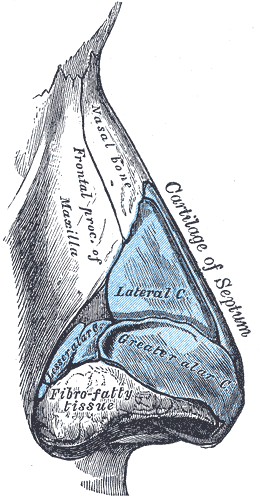Nasal bridge on:
[Wikipedia]
[Google]
[Amazon]

 The nasal bridge is the upper, bony part of the
The nasal bridge is the upper, bony part of the
Genetic Hearing Loss
from UTMB, Dept. of Otolaryngology. DATE: March 17, 2004. RESIDENT PHYSICIAN: Jing Shen. FACULTY PHYSICIAN: Ronald W. Deskin, MD. SERIES EDITORS: Francis B. Quinn, Jr., MD and Matthew W. Ryan, MD. Dystopia canthorum is associated with

 The nasal bridge is the upper, bony part of the
The nasal bridge is the upper, bony part of the human nose
The human nose is the most protruding part of the face. It bears the nostrils and is the first organ of the respiratory system. It is also the principal organ in the olfactory system. The shape of the nose is determined by the nasal bones ...
, which overlies the nasal bone
The nasal bones are two small oblong bones, varying in size and form in different individuals; they are placed side by side at the middle and upper part of the face and by their junction, form the bridge of the upper one third of the nose.
Eac ...
s.
Association with epicanthic folds
Low-rooted nasal bridges are closely associated withepicanthic fold
An epicanthic fold or epicanthus is a skin fold of the upper eyelid that covers the inner corner (medial canthus) of the eye. However, variation occurs in the nature of this feature and the possession of "partial epicanthic folds" or "slight ...
s. A lower nasal bridge is more likely to cause an epicanthic fold, and vice versa.
Dysmorphology
A lower or higher than average nasal bridge can be a sign of variousgenetic disorder
A genetic disorder is a health problem caused by one or more abnormalities in the genome. It can be caused by a mutation in a single gene (monogenic) or multiple genes (polygenic) or by a chromosomal abnormality. Although polygenic disorders ...
s, such as fetal alcohol syndrome. A flat nasal bridge can be a sign of Down syndrome
Down syndrome or Down's syndrome, also known as trisomy 21, is a genetic disorder caused by the presence of all or part of a third copy of chromosome 21. It is usually associated with physical growth delays, mild to moderate intellectual dis ...
(Trisomy 21), Fragile X syndrome
Fragile X syndrome (FXS) is a genetic disorder characterized by mild-to-moderate intellectual disability. The average IQ in males with FXS is under 55, while about two thirds of affected females are intellectually disabled. Physical features may ...
, 48,XXXY variant Klinefelter syndrome
Klinefelter syndrome (KS), also known as 47,XXY, is an aneuploid genetic condition where a male has an additional copy of the X chromosome. The primary features are infertility and small, poorly functioning testicles. Usually, symptoms are su ...
, or Bartarlla-Scott syndrome
Xylosyltransferase 1 is an enzyme that in humans is encoded by the ''XYLT1'' gene.
Xylosyltransferase (XT; EC 2.4.2.26) catalyzes the transfer of UDP-xylose to serine residues within XT recognition sequences of target proteins. Addition of this ...
.
An appearance of a widened nasal bridge can be seen with dystopia canthorum
Telecanthus, or dystopia canthorum, refers to increased distance between the inner corners of the eyelids (medial canthi), while the inter-pupillary distance is normal. This is in contrast to hypertelorism, in which the distance between the wh ...
, which is a lateral displacement of the inner canthi
The canthus (pl. canthi, palpebral commissures) is either corner of the eye where the upper and lower eyelids meet. More specifically, the inner and outer canthi are, respectively, the medial and lateral ends/angles of the palpebral fissure.
T ...
of the eyes.from UTMB, Dept. of Otolaryngology. DATE: March 17, 2004. RESIDENT PHYSICIAN: Jing Shen. FACULTY PHYSICIAN: Ronald W. Deskin, MD. SERIES EDITORS: Francis B. Quinn, Jr., MD and Matthew W. Ryan, MD. Dystopia canthorum is associated with
Waardenburg syndrome
Waardenburg syndrome is a group of rare genetic conditions characterised by at least some degree of congenital hearing loss and pigmentation deficiencies, which can include bright blue eyes (or Heterochromia iridum, one blue eye and one brown ey ...
.
See also
*Aquiline nose
An aquiline nose (also called a Roman nose) is a human nose with a prominent bridge, giving it the appearance of being curved or slightly bent. The word ''aquiline'' comes from the Latin word ''aquilinus'' ("eagle-like"), an allusion to the curved ...
* Bridge piercing
A bridge piercing is a facial piercing through the skin on the bridge of the nose, usually directly between the eyes of the wearer. A variation on this piercing, the vertical bridge piercing is a surface piercing, with all of the risks or potentia ...
References
Nose {{musculoskeletal-stub